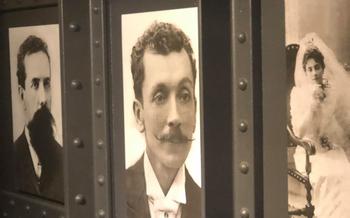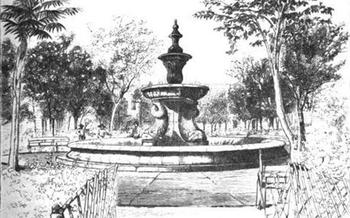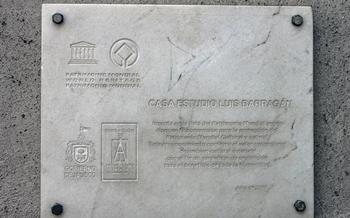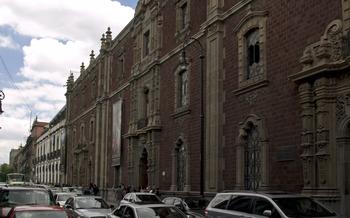
Interactive Museum of Economics
- Interactive Museum of Economics: A Unique Experience in Mexico City
- Location and Accessibility
- Hours of Operation and Admission Fees
- Exhibits and Displays: A Journey Through Economic Concepts
- Historical Context: The Evolution of Economic Thought
- Global Economic Issues: Exploring Challenges and Solutions
- Financial Literacy: Empowering Visitors with Practical Knowledge
- Educational Programs and Workshops
- Interactive Activities for Children and Families
- Accessibility for Visitors with Disabilities
- Temporary Exhibitions and Special Events
- Visitor Reviews and Testimonials
- Tips for a Memorable Visit
- Insider Tip: Unveiling the Hidden Gem of Economic Insights
Interactive Museum of Economics: A Unique Experience in Mexico City
Nestled in the heart of Mexico City, the Interactive Museum of Economics (MIDE) stands as a testament to the power of immersive learning and hands-on engagement. Founded in 1994, MIDE is a pioneering institution dedicated to making economics accessible, interactive, and enjoyable for visitors of all ages and backgrounds. With its innovative exhibits, engaging activities, and thought-provoking installations, MIDE invites visitors on a journey through the world of economics, empowering them with a deeper understanding of its complexities and relevance to everyday life.
The museum's mission is to promote economic literacy and foster a culture of informed decision-making. Through its interactive exhibits, MIDE aims to demystify economic concepts, challenge conventional thinking, and spark curiosity about the role of economics in shaping our world. Whether you're a student, a professional, or simply curious about how the economy works, MIDE offers a unique and enriching experience that will leave you inspired and informed.
Location and Accessibility
Situated amidst the vibrant streets of Mexico City, the Interactive Museum of Economics stands as a testament to the dynamic relationship between finance and culture. Nestled within the heart of the bustling Centro Historico, the museum's address—Calle Tacuba 17, Col. Centro—positions it as a convenient stop for any visitor exploring the city's captivating attractions.
Being in close proximity to other prominent landmarks, such as the Palacio Nacional and the Templo Mayor, the museum offers a seamless transition from historical exploration to economic enlightenment. The ease of access is further enhanced by its proximity to public transportation hubs, including the Metro and Metrobus stations. Whether you prefer the convenience of the underground or the panoramic views from the elevated buses, reaching the Interactive Museum of Economics is a hassle-free experience.
For those who prefer the comfort of their own vehicles, the museum provides ample parking options nearby, ensuring a smooth transition from the bustling streets to the tranquil ambiance of the museum's exhibits. To assist with navigation, a map or directions to the museum can be easily accessed online, guiding visitors swiftly to the doorsteps of this economic haven.
Hours of Operation and Admission Fees
The Interactive Museum of Economics is open to the public from Tuesday to Sunday, with varying hours depending on the day of the week. On Tuesdays, Wednesdays, and Fridays, the museum is open from 10 am to 5 pm. On Thursdays, it extends its hours from 10 am to 7 pm, allowing visitors more time to explore the exhibits. During the weekends, the museum is open from 11 am to 6 pm on Saturdays and 11 am to 5 pm on Sundays.
Admission fees are structured to provide accessibility to visitors from diverse backgrounds. Adults are charged a standard fee, while children between the ages of 3 and 12, students with valid IDs, and seniors over 60 are eligible for discounted rates. To encourage families to visit together, the museum offers a special family package that provides discounted admission for two adults and two children. Additionally, the museum offers free admission on the last Tuesday of every month, making it an excellent opportunity for budget-conscious visitors to experience the exhibits.
Exhibits and Displays: A Journey Through Economic Concepts
The Interactive Museum of Economics captivates visitors with its diverse array of interactive exhibits that bring economic concepts to life. Engage in a simulated stock market where you can make real-time trading decisions and witness the consequences. Step into the shoes of a central banker and adjust interest rates to control inflation. Experience the challenges of income inequality through a hands-on simulation that demonstrates the impact of different policies on wealth distribution.
These interactive exhibits not only entertain but also educate, making complex economic principles accessible to people of all ages and backgrounds. Visitors can experiment, test their understanding, and gain a deeper appreciation for the intricate workings of the global economy. Whether you're a student, a professional, or simply curious about economics, these exhibits offer a unique and engaging learning experience.
Through interactive simulations, multimedia displays, and hands-on activities, the museum encourages visitors to think critically, question assumptions, and develop a holistic understanding of economic phenomena. It's a place where abstract theories become tangible, and where visitors leave with a newfound appreciation for the role of economics in shaping our world.
Historical Context: The Evolution of Economic Thought
The Interactive Museum of Economics not only delves into contemporary economic concepts but also explores the fascinating history of economic thought. Journey through the ages as you learn about the major schools of thought that have shaped our understanding of economics. From the classical economists like Adam Smith and David Ricardo to the Keynesian revolution and the rise of behavioral economics, the museum showcases the evolution of ideas that have influenced economic policies and shaped societies worldwide.
Discover how economic theories have been tested and refined over time, and how they have responded to changing global circumstances. Through interactive exhibits, you'll gain insights into the lives and contributions of influential economists, tracing the intellectual lineage that has led to our current understanding of economic principles. The museum's historical exhibits provide a valuable context for understanding the complexities of modern economics and appreciating the intellectual journey that has brought us to where we are today.
Global Economic Issues: Exploring Challenges and Solutions
The Interactive Museum of Economics delves into the complexities of global economic issues, shedding light on pressing challenges and potential solutions. Exhibits address topics such as poverty, inequality, and sustainable development, inviting visitors to engage with these issues through interactive simulations and discussions. Visitors grapple with real-world scenarios, exploring the consequences of policy decisions and resource allocation. The museum promotes critical thinking and encourages visitors to become active global citizens, fostering a sense of responsibility and understanding for the interconnectedness of global economies. Through these exhibits, visitors gain insights into the root causes of global challenges and are inspired to contribute to positive change.
Financial Literacy: Empowering Visitors with Practical Knowledge
The Interactive Museum of Economics recognizes the importance of financial literacy and has dedicated exhibits that address this crucial aspect. Visitors can explore interactive displays that teach them about personal finance, budgeting, and investment. These exhibits aim to demystify complex financial concepts and empower visitors with practical knowledge to make informed financial decisions.
One popular exhibit, "The Budget Balancing Act," allows visitors to create a virtual budget and make choices about income, expenses, and savings. By simulating real-life scenarios, this exhibit demonstrates the importance of financial planning and the consequences of financial decisions.
Another highlight is the "Investment Adventure" exhibit, which introduces visitors to the world of investing. Through interactive games and simulations, visitors learn about different investment strategies, risk management, and the potential rewards and risks of investing.
The museum also offers workshops and seminars on topics such as retirement planning, money management, and consumer rights. These educational programs are designed to help visitors gain the skills and knowledge they need to achieve financial stability and make informed financial choices throughout their lives.
By providing practical financial education, the Interactive Museum of Economics empowers visitors to take control of their finances, make informed decisions, and achieve their financial goals.
Educational Programs and Workshops
The Interactive Museum of Economics offers a variety of educational programs and workshops designed to complement its exhibits and provide visitors with a deeper understanding of economic concepts. These programs are tailored to different age groups and skill levels, catering to students, adults, and families alike.
The museum's educational programs cover a wide range of topics, including personal finance, entrepreneurship, and global economics. Workshops are conducted by experienced educators and economists who use interactive activities, case studies, and simulations to make learning fun and engaging.
One popular program is the "Economics for Kids" workshop, which introduces young learners to basic economic principles through hands-on activities and games. Another popular offering is the "Financial Literacy for Adults" workshop, which provides practical advice on budgeting, saving, and investing.
The Interactive Museum of Economics also offers specialized workshops for teachers and educators, enabling them to incorporate economic concepts into their classroom teaching. These workshops provide teachers with resources, lesson plans, and strategies for making economics relevant and accessible to students.
Participants in the museum's educational programs often leave with a newfound appreciation for economics and a better understanding of how it affects their daily lives. Many participants have commented on how the workshops have helped them make more informed financial decisions, develop entrepreneurial skills, and engage in discussions about global economic issues.
Interactive Activities for Children and Families
The Interactive Museum of Economics recognizes the importance of engaging younger visitors in economic education. To this end, the museum has dedicated spaces and exhibits specifically designed for children and families. These exhibits transform learning into an interactive adventure, making economics relatable and fun for kids of all ages.
One popular exhibit is the "Mini Market," where children can play the role of shoppers and vendors, learning about supply and demand while making purchasing decisions. Another favorite is the "Money Factory," where kids can design their own currency and explore the history of money.
The museum also offers workshops and programs tailored to children's interests and learning styles. These programs use games, stories, and hands-on activities to introduce economic concepts in a way that is both enjoyable and educational.
Parents can rest assured that their children will have a meaningful and enriching experience at the Interactive Museum of Economics. The exhibits are designed to spark curiosity, encourage critical thinking, and foster a love of learning.
Here's a heartwarming anecdote: During a recent visit, I observed a young girl engrossed in the "Budgeting Game." As she carefully allocated her virtual income to various expenses, her excitement was palpable. It was evident that she was not only learning about financial responsibility but also developing valuable life skills.
To make the most of your family's visit, consider these tips:
- Plan to spend at least two hours exploring the exhibits.
- Encourage your children to ask questions and interact with the museum staff.
- Take advantage of the educational programs and workshops offered throughout the year.
- Make it a fun and interactive experience by playing along and engaging with your children.
Accessibility for Visitors with Disabilities
The Interactive Museum of Economics is committed to creating an inclusive and welcoming environment for all visitors, including those with disabilities. The museum features a range of accessibility features to ensure that everyone can enjoy and learn from the exhibits.
Wheelchair ramps and elevators provide easy access to all floors of the museum, and wide aisles allow for comfortable movement throughout the exhibits. Audio guides are available for visitors with visual impairments, and staff members are trained to assist visitors with any special needs.
The museum also offers a variety of programs and resources designed specifically for visitors with disabilities. Guided tours with sign language interpreters are available upon request, and educational workshops are adapted to accommodate the needs of participants with different disabilities.
One visitor with a disability shared their experience at the museum:
"I was so impressed with the accessibility features at the Interactive Museum of Economics. I was able to navigate the exhibits easily with my wheelchair, and the staff was incredibly helpful and accommodating. I learned so much about economics, and I had a great time exploring the museum."
The museum's commitment to accessibility ensures that everyone has the opportunity to learn about economics and explore the world of finance.
Temporary Exhibitions and Special Events
The Interactive Museum of Economics keeps its offerings fresh and exciting through temporary exhibitions and special events that complement the permanent exhibits. These events provide visitors with new perspectives on economic issues and offer a chance to engage with experts and fellow enthusiasts.
The museum's calendar is packed with events throughout the year, including lectures, workshops, conferences, and film screenings. These events are a great way to learn about cutting-edge research, network with professionals in the field, and participate in discussions on pressing economic issues.
To stay informed about upcoming events, visitors can check the museum's website or subscribe to its newsletter. Past events have covered a wide range of topics, from the history of economic thought to the latest developments in behavioral economics.
One of the highlights of the museum's event calendar is the annual "Economics in Action" festival. This multi-day event features interactive exhibits, hands-on activities, and presentations by leading economists. It's a great opportunity for visitors of all ages to learn about economics and how it affects their daily lives.
By offering a variety of temporary exhibitions and special events, the Interactive Museum of Economics ensures that there's always something new to discover and explore. These events make the museum a dynamic and engaging space that encourages visitors to think critically about economic issues and their impact on society.
Visitor Reviews and Testimonials
Visitors to the Interactive Museum of Economics have consistently raved about their experiences, praising the museum's innovative approach to teaching economic concepts. Many reviewers highlight the museum's ability to make complex economic principles accessible and engaging, even for those with no prior knowledge of the subject. The interactive exhibits are a particular hit, with visitors describing them as "mind-blowing," "addictive," and "the perfect way to learn about economics."
One visitor, a high school economics teacher, said, "I brought my class to the museum, and they were absolutely captivated. They learned more in a few hours than they had in weeks of traditional lectures."
Another visitor, a retired economist, said, "I've been to countless museums around the world, but the Interactive Museum of Economics is truly one of a kind. It's a must-visit for anyone interested in understanding how the economy works."
The museum's reputation for excellence is reflected in its numerous awards and accolades. It has been recognized by organizations such as the Mexican Academy of Economics, the National Council of Science and Technology, and the International Museum of the Year Awards.
These positive reviews and testimonials are a testament to the Interactive Museum of Economics' success in fulfilling its mission to make economics accessible and relevant to everyone.
Tips for a Memorable Visit
To fully immerse yourself in the museum's offerings, plan to spend at least two to three hours exploring the exhibits. This will give you ample time to engage with the interactive displays, watch informative videos, and participate in hands-on activities.
To avoid crowds and ensure a more enjoyable experience, consider visiting the museum on weekdays, particularly in the morning hours. This will allow you to navigate the exhibits at your own pace and receive personalized attention from the museum staff.
Before your visit, check the museum's website or social media pages for any special events, workshops, or guided tours that may be offered during your stay. These events provide an excellent opportunity to learn more about specific economic topics and engage with experts in the field.
To capture memorable photos, take advantage of the museum's vibrant displays and interactive exhibits. Don't forget to share your experiences on social media using the museum's designated hashtags to connect with other visitors and share your economic insights.
Remember, the Interactive Museum of Economics is a place where learning and exploration intersect. Embrace the opportunity to engage with the exhibits, ask questions, and discover the fascinating world of economics in a fun and interactive way.
Insider Tip: Unveiling the Hidden Gem of Economic Insights
Amidst the captivating exhibits at the Interactive Museum of Economics, there lies a hidden gem that offers a profound journey into the intricacies of economic decision-making. Tucked away in a secluded corner, the Behavioral Economics exhibit delves into the fascinating realm of how human psychology influences economic behavior. Through interactive simulations and thought-provoking scenarios, visitors can explore the biases, heuristics, and emotional factors that shape their financial choices.
This hidden gem challenges conventional economic models that assume rational decision-making and reveals the often irrational and emotional side of human behavior in economic contexts. Visitors can test their own cognitive biases through interactive games and gain insights into why they make the choices they do, even when faced with seemingly logical alternatives.
Unveiling this hidden gem is like discovering a secret treasure trove of economic knowledge. It provides a unique perspective on the interplay between psychology and economics, highlighting the importance of understanding human behavior to make informed financial decisions. Whether you're an economics enthusiast or simply curious about the factors that influence your spending habits, the Behavioral Economics exhibit is a must-see for anyone seeking a deeper understanding of economic phenomena.









